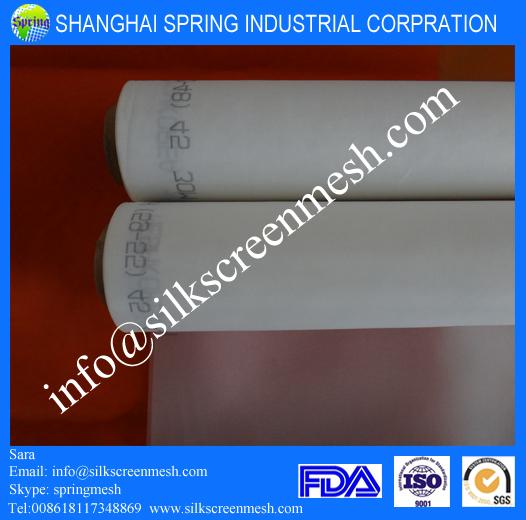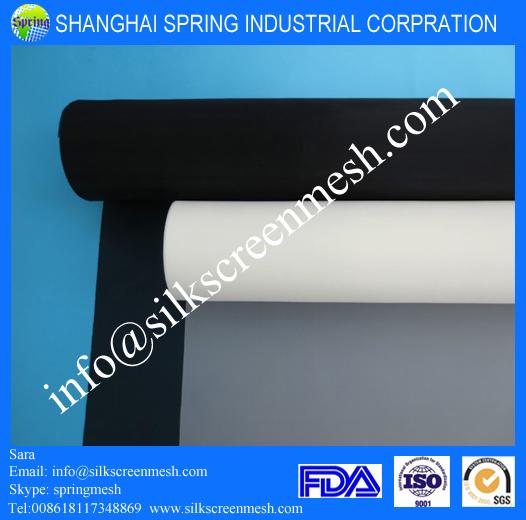There are a lot of choices out there, and many printers will often find one mesh they are comfortable with and stick with it for all their printing needs. This is a huge mistake. With the right knowledge you can make informed mesh decisions that will make for sharper prints, reduced ink costs, and an overall better printing experience.
How to choose right mesh fabrics
The screen printing mesh you will use will be determined by:
1. What you are printing onto.
2. What ink you will be using.
3. The detail in your design.
The main index of characteristic of screenprinting screens
The usual mesh screen printing is silk screen, nylon mesh, polyester screen printing mesh, stainless steel wire mesh. The main index of characteristic of various screen printing screen mesh as below:
(1)Tensile strength [g/d (g/diameter)] silk fabrics 3.7- 4.1 g/d, nylon mesh for screen printing 4.5- 5.8 g/d, polyester printing mesh 4.3- 5.5 g/d, stainless steel wire mesh 1.5 g/d.
(2)Ratio of wet- and- dry strength (%), silk screen 92 ~ 100%, nylon screen mesh cloth 89-90%, polyester screen mesh 100%, monofilament screens stainless 100%.
(3)Knot strength [g/d (g/diameter)], silk mesh screen 2.9 g/d, nylon screen mesh fabric 4.5-5.4 g/d, polyester fabric for screen printing 3. 4-4.4 g/d.
(4)Tensile elongation (%), silk screen mesh 8 ~ 22%, nylon screenprint mesh 26 ~ 32%, polyester screenprinting fabric 16 ~ 30%, stainless steel screenprinting screens is 38%.
(5)Elongation dry and wet ratio (%), tulle 120 ~ 134%, nylon screen printing mesh fabric 115-122%, polyester mesh screen printing 100%, stainless steel mesh of silk screen 100%.

A lower number means a coarser polyester screen printing mesh , a higher number means a finer mesh count. You will need to select the correct silk screen printing mesh count for the artwork you have produced.
Finer mesh counts for printing with water based inks will prove more difficult because the ink will dry up too quickly on the finer mesh counts.
With over 400 different polyester screen printing mesh fabric to choose from, selecting the correct mesh screen printing size can be a frustrating process. Use the following information as a general guideline for silkscreen fabric selection.
(1)43T polyester silk screen printing mesh is used most commonly for general textile printing.
(2)Use 30 threads per inch polyester printing screen/mesh (12 threads per centimeter) for printing glitter inks.
(3)Use 60 threads per inch screenprinting fabric (24 threads per centimeter) for athletic printing, opaque ink deposits, thick puff ink, and shimmer ink.
(4)Use 85 threads per inch monofilament polyester screen printing mesh (34 threads per centimeter) for heavy coverage on dark shirts, solid under-base prints, puff, metallic, and shimmer inks, and transfer printing.
(5)Use 125 threads per inch printing screen mesh (49 threads per centimeter) for general printing on dark shirts, under-base prints with detail, prints on dark nylon jackets, and silver shimmer ink.
(6)Use 180 threads per inch silk screen mesh for printing (71 threads per centimeter) for muti color printing on light shirts, light colored nylon jackets.
(7)Use 230 threads per inch mesh for screen printing (90 threads per centimeter) for detailed muti color printing on light shirts, light nylon jackets, over printing on dark shirts.
(8)Use 305 thread per inch high tension silk screen printing mesh (120 threads per centimeter) for process color on light shirts, overprinting on dark shirts.


 Your message must be between 20-3,000 characters!
Your message must be between 20-3,000 characters! Please check your E-mail!
Please check your E-mail!  Your message must be between 20-3,000 characters!
Your message must be between 20-3,000 characters! Please check your E-mail!
Please check your E-mail! 



